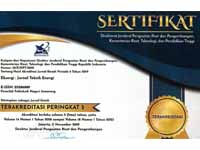Effectiveness of Brackish Water Desalination Using Reverse Osmosis System for Industrial Water Treatment at PLTU PT Bintan Alumina Indonesia
DOI:
https://doi.org/10.32497/eksergi.v19i03.4717Keywords:
Demineralized water, boiler feed, PLTU, Water Treatment Plant, reverse osmosis.Abstract
Abstract- Demineralized water is water that does not contain high minerals or chemicals, and is used as feed to the boiler to produce steam. Demineralized water is very important in the PLTU (Steam Power Plant) industry because steam is produced through the process of changing the phase of water to steam. Natural water tends to be corrosive because it contains minerals such as high calcium and magnesium, which can cause scale in the boiler and reduce energy efficiency. Therefore, these minerals must be removed from the water so that they can be used as boiler feed. To produce demin water, PT. BAI uses a Water Treatment Plant (WTP) system which consists of several stages, such as a clarifier, a three-layer filter, an automatic cleaning filter, ultra-filtration and reverse osmosis. After going through these processes, demin water is stored in tanks and then flowed to the main plant. There are several factors that can interfere with the demin water production process at PT. BAI, including changes in water quality, problems with WTP equipment, and disturbances in the water distribution system. This study aims to maintain the reliability and efficiency of the demin water production process, by carrying out routine maintenance on equipment, monitoring water quality by checking conductivity, pH levels, and produced water. Then from the data obtained it can be seen that the efficiency of demin water has met the operating standards and procedures set by PT.BAI, namely desalination levels above 90%. The division must also always be ready to deal with problems that occur and take preventive actions to prevent disruption to the production process.
References
Malik Maulana, Abdul and Widodo, Ariyanto S (2009) Pengolahan Air Produk Reverse Osmosis Sebagai Umpan Boiler Dengan Menggunakan Ion exchange.
M. Ivan Mahdi, “ Kualitas air Indonesia memburuk pada 2021”
Rositayanti Hadisoebroto, “KAJIAN POLA PEMAKAIAN AIR BERSIH DI TIGA APARTEMEN DI JAKARTA” Trisakti, Jakarta Barat, 2009.
ELSYA ARILY YUNANDA,” DESALINASI AIR PAYAU MENJADI AIR BERSIH
DENGAN MENGGUNAKAN METODE REVERSE OSMOSIS”ITS, Surabaya, 2017.
Suryadi, “Analisa Teknis Ekonomis Perencanaan Sistem Reverse Osmosis Untuk Kebutuhan,” ITS, Surabaya, 2011.
Lanxess, principle of reverse osmosis membrane separation, Deutschland, 2013.
I. n. w. Linda A.Yoshi, “Sistem Desalinasi Membran Reverse Osmosis (RO) untuk Penyediaan air bersih,” 2016.
Horas Tiopan Sanjaya “PERANCANGAN SISTEM DESALINASI MENGGUNAKAN METODE REVERSE OSMOSIS PADA KAPAL RO-RO FERRY 5000 GT” ITS, 2018.
Aan Sefentry, Rully Masriatini “PEMANFAATAN TEKNOLOGI MEMBRAN REVERSE OSMOSIS (RO) PADA PROSES PENGOLAHAN AIR LAUT MENJADI AIR BERSIH” , Universitas PGRI Palembang, 2020.
Muhammad Ali Irfan, Djoko Wahyudi, Indro Wicaksono “Analisis Pengaruh Tekanan Membran Terhadap Kinerja Reverse Osmosis PLTU Paiton Unit 9”,Universitas Panca Marga, 2017.
Suardi, Rudi.2001. Sistem Manajemen Mutu ISO 9000:2000 , PPM, Jakarta.
Iqbal, Farid. 2014. Reverse Osmosis. Water treatment plant, Jakarta.e Limited.
C.B. Rasrendra & Hanggara Sukandar, 2002, Desalinasi dengan Reverse Osmosis Tekanan Rendah, Departemen Teknik Kimia Institut Teknologi Bandung.
Downloads
Additional Files
Published
Issue
Section
License
Authors who publish with this journal agree to the following terms:Authors retain copyright and grant the journal right of first publication with the work simultaneously licensed under a Creative Commons Attribution License that allows others to share the work with an acknowledgement of the work's authorship and initial publication in this journal.
Authors are able to enter into separate, additional contractual arrangements for the non-exclusive distribution of the journal's published version of the work (e.g., post it to an institutional repository or publish it in a book), with an acknowledgement of its initial publication in this journal.
Authors are permitted and encouraged to post their work online (e.g., in institutional repositories or on their website) prior to and during the submission process, as it can lead to productive exchanges, as well as earlier and greater citation of published work (See The Effect of Open Access).






